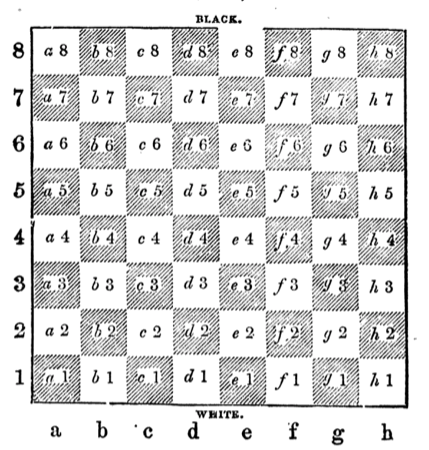This article is slightly different from the others you can find on this website. Indeed, it is not about moves, plans, ideas, tactical lines, but how you reflect them and write about them. Most of the Chess games you will see are written down in PGN notation.
If you want to study Chess, even a little bit, you will be confronted with many signs and acronyms that are used to describe the moves of a Chess game. Thus you should get familiar with the Algebraic notation, which is the most common notation used in Chess today. Note that there are other notations such as the descriptive notation and the Extended position description, but they are more difficult to grasp and far less common.
At the end of this article, you will be able to understand things such as:
1. Nxc7+ Kd8
or
23… O-O-O 24. exf6
Pieces
In the Chess notation, each piece is designed by a letter:
K stands for King
Q stands for Queen
R stands for Rook
B stands for Bishop
N stands for Knight
no letter stands for Pawn
Moves
A move is identified by the arrival square.
Numbering
The moves are numbered the following way:
- e4 Nf6 2. Nc3
means “on the first move, White has moved his pawn to e4 and then Black has moved his Knight to f6. On the second move, White plays the Knight on c3.”. This is the following line:
Captures
A capture in Chess is indicated by the letter “x”:
Note: in the case of the pawn, to avoid confusion, the origin file is mentioned:
exf5: the “e” pawn captures on f5.
Special moves
Castling is described by the notations O-O (castling short) and O-O-O (castling long). You will sometimes see it annotated with “0” (zero) instead of “O” (capital o): 0-0 and 0-0-0.
The “en passant” capture is based on the arrival square as well.
A piece promotion in Chess is indicated by the symbol “=”:
a8=Q: the pawn goes to a8 and promotes to a Queen.
c8=R: the pawn goes to c8 and promotes into a Rook.
The check is indicated by the sign “+”.
Removing ambiguity
In case the piece and the arrival square are not enough to identify the move, the starting file is added.
In case the piece, the arrival square, and the starting file are not enough to identify the move, the starting rank is added (without the file).
Checking Your Understanding Of Chess PGN
Conclusion on PGN and other Chess stuff
Congratulations ! You know everything about the basic moves, capturing, mating, drawing and all the special moves. Even the notation has no secret for you now.
You are now ready to start learning about strategy, tactics, exchanges, traps, value of the pieces, basic mates and so on. There is a long and exciting way to go to become a brilliant player. The journey is long, but it is rewarding…
The next articles will be dedicated to chess pieces value, exchanging pieces, the difference between stalemate and checkmate, and basic mating patterns like checkmate wit one Queen, check those lessons to keep improving your Chess knowledge !



